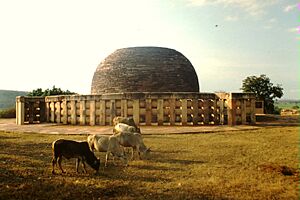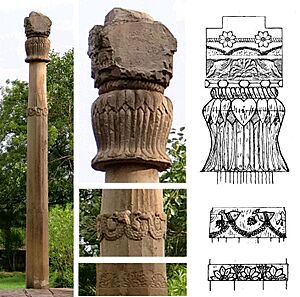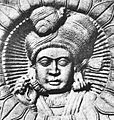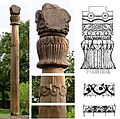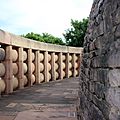Shunga Empire facts for kids
The Shunga Empire was an ancient Indian kingdom. It was started by Pushyamitra Shunga around 185 BCE. He was a general who took over from the last ruler of the Mauryan Empire, Brihadratha Maurya. The capital city of the Shunga Empire was Pataliputra.
Pushyamitra Shunga ruled for 36 years. After him, his son Agnimitra became the ruler. There were ten Shunga rulers in total. However, after Agnimitra passed away, the empire started to become weaker.
The Shunga Empire was known for fighting many wars. They battled against different kingdoms and powers. These included the Kalinga, the Satavahana dynasty, and the Indo-Greek Kingdom. They might have also fought against the Panchalas and Mathuras.
During the Shunga period, many good things happened in art, education, and philosophy. People learned a lot and new ideas developed. A famous book called Mahābhāṣya by Patanjali was written during this time. The Kanva dynasty took over from the Shungas around 73 BCE.
Shunga Rulers
The Shunga Empire had a line of ten emperors. Here is a list of them and how long they ruled:
| Emperor | Time They Ruled |
|---|---|
| Pushyamitra Shunga | 185–149 BCE |
| Agnimitra | 149–141 BCE |
| Vasujyeshtha | 141–131 BCE |
| Vasumitra | 131–124 BCE |
| Bhadraka (also known as Ardraka or Odruka) | 124–122 BCE |
| Pulindaka | 122–119 BCE |
| Ghosha (also known as Ghoshavasu) | 119-108 BCE |
| Vajramitra | 108-94 BCE |
| Bhagabhadra (also known as Bhagavata) | 94-83 BCE |
| Devabhuti | 83–73 BCE |
Art and Architecture
The Shunga period was important for art and building. Many famous structures and sculptures were made. The stupa at Sanchi was greatly expanded during this time. The Shungas added stone coverings and railings to it.
Images for kids
-
Shunga royal family, West Bengal, 1st century BCE.
-
Shunga period stupa at Sanchi.
-
East Gateway and Railings, Red Sandstone, Bharhut Stupa, 2nd century BCE. Indian Museum, Kolkata.
-
Vedika pillar with "Yavana" Greek warrior. Bharhut, Madhya Pradesh, Shunga Period, c. 100-80 BC. Reddish brown sandstone. Indian Museum, Calcutta.
-
The Yavanarajya inscription, dated to "year 116 of Yavana hegemony", probably 70 or 69 BCE, was discovered in Mathura. Mathura Museum.
-
The Heliodorus pillar was built in Vidisha under the Shungas, at the instigation of Heliodorus, ambassador of the Indo-Greek king Antialcidas. The pillar originally supported a statue of Garuda. Established circa 100 BCE.
-
Baluster-holding yakṣa, Madhya Pradesh, Shunga period (2nd–1st century BCE). Guimet Museum.
See also
 In Spanish: Imperio Śuṅga para niños
In Spanish: Imperio Śuṅga para niños


